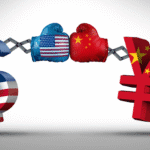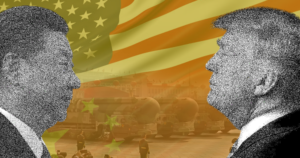A dramatic and potentially historic ceasefire between Iran and Israel was declared on June 23–24, 2025, after nearly two weeks of direct military exchanges that included strikes on Iranian nuclear facilities and retaliatory missile attacks on Israeli territory. The agreement, mediated by U.S. President Donald Trump with the diplomatic backing of Qatar and Iraq, signals a temporary cooling of a highly volatile confrontation. But beneath the surface, the ceasefire remains fragile, contested, and entangled with wider regional dynamics—especially the unresolved crisis in Gaza.
Terms of the Ceasefire
According to multiple sources, the agreement calls for an immediate halt to hostilities on both sides, with Iran ceasing missile and drone attacks in exchange for an Israeli suspension of airstrikes starting at 4 a.m. Tehran time on June 24. President Trump announced that “the ceasefire is now in effect”, framing it as a major diplomatic win. However, within hours, Israeli Defense Minister Yoav Gallant accused Iran of breaching the ceasefire by launching additional projectiles, prompting further Israeli strikes in self-defense. Iran denied the accusation and claimed it remained committed to the terms. This immediate dispute illustrates the highly unstable nature of the agreement and the lack of a credible verification mechanism.
Prospects for Sustainability
Critically, the ceasefire does not address the core strategic issues driving both sides’ hostilities. On Israel’s side, concerns remain over Iran’s uranium enrichment activities, ballistic missile programs, and its support for proxy forces such as Hezbollah and militias in Syria and Iraq. From Iran’s perspective, Israel’s ongoing airstrikes across the region, its undeclared nuclear arsenal, and its deepening military alliances with the U.S. and Gulf states are equally viewed as existential threats. The ceasefire, while halting direct fire for now, leaves these root causes of tension unresolved—and without sustained diplomatic engagement on both sides, the risk of renewed conflict remains high.
The agreement also exposes internal pressures within both countries. Iran’s leadership, having absorbed a wave of highly effective Israeli cyber and kinetic strikes on critical military facilities, now faces domestic criticism and calls for retribution. Simultaneously, Israel’s far-right coalition has been emboldened by what it sees as a successful defense of its red lines. These internal dynamics may push both governments toward re-escalation, particularly if public perception of deterrence or credibility is challenged.
U.S. involvement in the ceasefire is both pivotal and deeply complicated by its own military actions. Just days before brokering the agreement, the United States carried out joint strikes with Israel on Iranian command centers and missile sites, marking one of the most direct U.S. military interventions against Iran in recent years. While President Trump has framed the subsequent ceasefire as a testament to “peace through strength,” critics argue that Washington’s dual role as both belligerent and mediator undermines its credibility. The timing of the intervention—months before a contentious U.S. election—has also led to skepticism about whether the ceasefire is a sustainable diplomatic achievement or a temporary political maneuver. Without broader international oversight or institutional support from key global players, many regional analysts fear that the ceasefire lacks the legitimacy and durability required to endure beyond the immediate crisis.
The Gaza Exception: No Ceasefire, No Relief
While global headlines fixate on the ceasefire between Iran and Israel, Gaza remains conspicuously absent from the diplomatic spotlight—and still under fire. In sharp contrast to the high-level negotiations that paused hostilities between two powerful regional actors, there has been no parallel ceasefire agreement in Gaza, where Israeli airstrikes continue and humanitarian conditions deteriorate by the day. The irony is glaring: a ceasefire was rapidly secured between sworn adversaries with nuclear capabilities and decades of enmity, yet no such agreement has been reached with Hamas, a group Israel has fought for decades and with whom it has repeatedly negotiated temporary truces in the past.
This disconnect reveals more than just a diplomatic oversight—it highlights Gaza’s peripheral status in the broader calculus of regional power. Despite being the flashpoint that catalyzed Iran’s initial retaliation and the subsequent Israeli escalation, Gaza is now functionally sidelined. Some Israeli officials argue that the truce with Iran could create leverage to press Hamas into a hostage deal or a local ceasefire, but there is no indication of active negotiations or political momentum on that front. On the contrary, the current calm between Iran and Israel may grant Israel more operational bandwidth to continue its campaign in Gaza with fewer external constraints.
At the same time, the people of Gaza are likely to feel the ceasefire most acutely—not through relief, but through isolation. The halt in long-range hostilities may narrow international attention back toward great-power diplomacy, diverting it away from Gaza’s humanitarian catastrophe. With infrastructure in ruins, hospitals collapsing, and aid access limited, the ceasefire elsewhere does nothing to interrupt the siege on Gaza. If anything, it may consolidate the idea that de-escalation is a luxury reserved for state actors with strategic leverage, not for civilian populations enduring protracted violence.
In that sense, the Iran-Israel ceasefire may serve not as a model for de-escalation in Gaza, but as a reminder of the political asymmetry that defines the conflict—and the diplomatic silence that often surrounds its most vulnerable front.
What Comes Next
This ceasefire, while halting a dangerous spiral, can be considered to buy time, not certainty. The absence of broader diplomatic architecture means the current pause is inherently unstable—vulnerable not only to violations but to the gravitational pull of unresolved ambitions, threats, and mistrust on all sides.
What happens next will depend less on declarations than on restraint. Whether leaders choose to use this moment to lay groundwork for deeper negotiation—or revert to military logic once the dust settles—will shape the regional landscape far more than the ceasefire’s initial success. The coming days are not about holding peace; they are about deciding whether this fragile quiet becomes a prelude to diplomacy or merely a lull before the next detonation.















